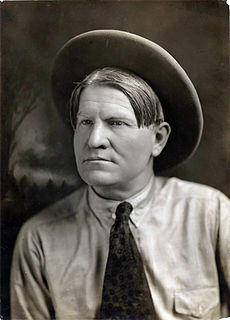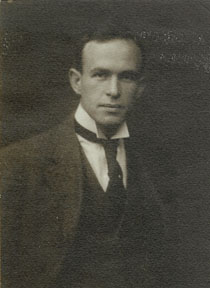
Charles Marion Russell, also known as C. M. Russell, Charlie Russell, and "Kid" Russell, was an American artist of the American Old West. He created more than 2,000 paintings of cowboys, Native Americans, and landscapes set in the western United States and in Alberta, Canada, in addition to bronze sculptures. He is known as "the cowboy artist" and was also a storyteller and author. He became an advocate for Native Americans in the west, supporting the bid by landless Chippewa to have a reservation established for them in Montana. In 1916, Congress passed legislation to create the Rocky Boy Reservation.

Red Cloud's War was an armed conflict between the Lakota, Northern Cheyenne, and Northern Arapaho on one side and the United States in Wyoming and Montana territories from 1866 to 1868. The war was fought over control of the western Powder River Country in present north-central Wyoming. This grassland, rich in buffalo, was traditionally Crow Indian land, but the Lakota had recently taken control. The Crow tribe held the treaty right to the disputed area, according to the major agreement reached at Fort Laramie in 1851. All involved in "Red Cloud's War" were parties in that treaty.
Montana is the 41st state to enter the United States, and has a culturally-diverse population representing a broad spectrum of music genre, style, and instrumentation.

Joseph Medicine Crow was a war chief, author, and historian of the Crow Nation of Native Americans. His writings on Native American history and reservation culture are considered seminal works, but he is best known for his writings and lectures concerning the Battle of the Little Bighorn in 1876. He received the Bronze Star Medal and the Légion d'honneur for service during World War II, and the Presidential Medal of Freedom in 2009.

The Crow Indian Reservation is the homeland of the Crow Tribe of Indians of the State of Montana in the United States. The reservation is located in parts of Big Horn, Yellowstone, and Treasure counties in southern Montana. It has a land area of 3,593.56 sq mi (9,307.27 km²) and a total area of 3,606.54 sq mi (9,340.89 km²), making it either the fifth or sixth largest reservation in the country. Reservation headquarters are in Crow Agency.

Pauline Small was the first woman to be elected to office in the Crow Tribe of Indians. In 1966 she was elected to Vice-Secretary of the Crow Tribal Council, holding office de facto to 1972, and served in various positions within the Crow Tribal Offices, many to do with supporting education.
Jaune Quick–to–See Smith, a self-described cultural arts worker, is a Native American visual artist and curator. She is an enrolled member of the Confederated Salish and Kootenai Tribes, and is also of Métis and Shoshone descent. She is also an art educator, art advocate, and political activist. She has been prolific in her long career, and her work draws from a Native worldview and comments on American Indian identity, histories of oppression, and environmental issues.

Joseph Henry Sharp was an American painter and a founding member of the Taos Society of Artists, of which he is considered the "Spiritual Father". Sharp was one of the earliest European-American artists to visit Taos, New Mexico, which he saw in 1893 with artist John Hauser. He painted American Indian portraits and cultural life, as well as Western landscapes. President Theodore Roosevelt commissioned him to paint the portraits of 200 Native American warriors who survived the Battle of the Little Bighorn. While working on this project, Sharp lived on land of the Crow Agency, Montana, where he built Absarokee Hut in 1905. Boosted by his sale of 80 paintings to Phoebe Hearst, Sharp quit teaching and began to paint full-time.

The following is an alphabetical list of articles related to the U.S. state of Montana.

James Luna was a Payómkawichum, Ipi, and Mexican-American performance artist, photographer and multimedia installation artist. His work is best known for challenging the ways in which conventional museum exhibitions depict Native Americans. With recurring themes of multiculturalism, alcoholism, and colonialism, his work was often comedic and theatrical in nature. In 2017 he was awarded a Guggenheim Fellowship.
Frank Bird Linderman was a Montana writer, politician, Native American ally and ethnographer. Born in Cleveland, Ohio, he went West as a young man and became enamored of life on the Montana frontier. While working as a trapper for several years, he lived with the Salish and Blackfeet tribes, learning their cultures. He later became an advocate for them and other northern Plains Indians. He wrote about their cultures, and worked to help them survive pressure from European Americans. For instance, he supported establishment of the Rocky Boy Indian Reservation in 1916 in Montana for landless Ojibwe (Chippewa) and Cree, and continued as an advocate for Native Americans to his death.

Allen Tupper True was an American illustrator, easel painter and muralist who specialized in depicting the American West.

Henry Real Bird, a member of the Crow Nation, is a poet.

The Regional designations of Montana vary widely within the U.S state of Montana. The state is a large geographical area that is split by the Continental Divide, resulting in watersheds draining into the Pacific Ocean, Gulf of Mexico and Hudson's Bay. The state is approximately 545 miles (877 km) east to west along the Canada–United States border and 320 miles (510 km) north to south. The fourth largest state in land area, it has been divided up in official and unofficial ways into a variety of regions. Additionally, Montana is part of a number of larger federal government administrative regions.
Robert "Bob" Coronato is an American painter and printmaker. Coronato is best known for his paintings of present-day Western Americana, cowboys, and American Indian life and culture.
Bently Spang is a Northern Cheyenne multidisciplinary artist, writer, and curator. His work has been exhibited widely in North America, South America, and Europe.

Wendy Red Star is a Native American contemporary multimedia artist born in Billings, Montana, in the United States. Her humorous approach and use of Native American images from traditional media draw the viewer into her work, while also confronting romanticized representations. She juxtaposes popular depictions of Native Americans with authentic cultural and gender identities. Her work has been described as "funny, brash, and surreal".
Jessie Spaulding Wilber was an American printmaker and educator.

Jackie Larson Bread is a Native American beadwork artist from the Blackfeet Reservation in Browning, Montana. Her interest in bead work was sparked from looking at her late-grandmother's beaded pieces. In awe of these objects, Bread self-taught herself how to bead when she was younger and now, she has been beading for more than 20 years. Continuing through trial and error, Bread has received numerous awards for her beading.
Jessica Louise Donaldson Schultz Graham (1887–1976) was an English professor at Montana State College and social worker on Native reservations in Montana and Wyoming.












